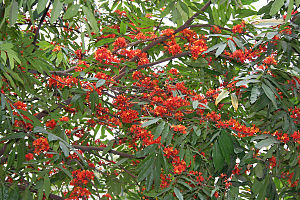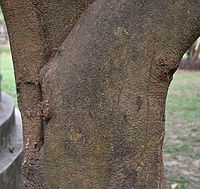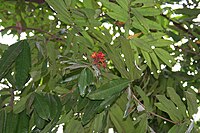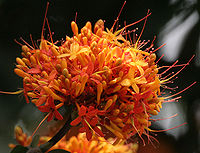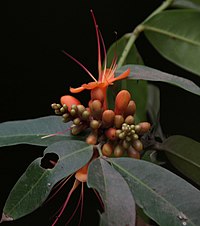Saraca indica
Read community contributed articles on biodiversity & environment || Cultural practices & mythological stories related to Indian biodiversity || Official documents related to environment || NGOs, Blogs and Websites || Environment-related video collection || Plants of India || Mammals of India || Facebook || Twitter
Share this page: Saraca indica
Saraca indica or the Ashoka tree is an important plant from a religious and cultural point of view in India. The tree has beautiful red flowers and a dense foliage which makes it seem stately to its devotees. The tree is a symbol of fertility in Indian culture and has been recently shown to provide relief to women during menstruation. The tree is revered in Hinduism and Buddhism and is frequently found in royal palace grounds or near temples.
Click here to see all Semantic Properties associated with this page
Please note that the above slideshow is automatically created by searching Flickr and does not contain manually curated images. Hence, it is likely that some images may not be exactly of Saraca indica.
Click on the tabs below to know more...
- Species identity and nomenclature
- Current Wikipedia entry
- Binomial Classification
- Morphological features
- Habitat and Geographical Spread
- Maps
- Medicinal Importance
- Cultural significance
- Commercial importance and cultivation
- Summary of PubMed articles
- Summary of NCBI molecular data
- External Links
- Images and Videos
| Parameter | Value(s) | References See complete references in the References section at the end |
|---|---|---|
| Names of users who have contributed to this species page | Gauravm | |
| Date on which this page was first created | 2010/09/02 | |
| This page was last modified on: | 6 September 2010 15:20:23 | |
| Name of the species | Saraca indica | |
| ID on Encyclopedia of Life | ||
| Synonyms | Please check Binomial Classification section for synonyms. | |
| Common English Names | Ashoka | |
| Common Hindi Names | अशोक Ashok | |
| Common Indian names | Sita Ashok सीता अशोक Sita Ashok, Ashok अशोक (Hindi); Ashopalava (Gujarati); Achenge (Kannada); Hemapushpam (Malayalam); Ashok, Jasundi (Marathi); அசோகம் Asogam (Tamil); Asokamu (Telugu) | Flowers of India |
| Origins/Meanings of the common names | Ashoka in Sanskrit means "without sorrow". It is said that Gautam Buddha was born under an Ashoka tree. The ashoka tree is often mentioned in classical Indian religious and amorous poetry, having at least 16 different names in Sanskrit referring to the tree or its flowers. | Wikipedia |
Taxonomy from Encyclopedia of Life
If nothing is displayed in this section, it means the EoL ID has not been defined. Please click on Edit with form button on top and follow the instructions for filling in the EoL ID
{{#EoLOnlyHierarchy:}}
Taxonomy filled in form
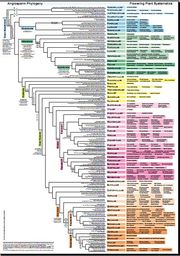
Click here for the PDF of the phylogeny
| Taxon | Value |
|---|---|
| Regnum (Kingdom) | Plantae |
| Division | Magnoliophyta |
| Class | Magnoliopsida |
| Order | Fabales |
| Family | Fabaceae |
| Genus | Saraca |
| Source of data | Encyclopedia of Life |
| ||||||||||||||||||||
| Division | Taxon details | Taxon morphology details |
|---|---|---|
| Magnoliophyta | Also called Angiospermae. The ancestors of flowering plants diverged from gymnosperms around 245–202 million years ago, and the first flowering plants known to exist are from 140 million years ago. They diversified enormously during the Lower Cretaceous and became widespread around 100 million years ago, but replaced conifers as the dominant trees only around 60-100 million years ago. | These are seed plants like Gymnosperms, but can be differentiated by the presence of flowers, seeds containing endosperm and seeds that produce a fruit. Angiosperms are the most diverse and highly evolutionarily successful group of land plants. |
| ||||||||||||||||||||
| Class | Taxon details | Taxon morphology details |
|---|---|---|
| Magnoliopsida | Magnoliopsida is the scientific name for dicots. This class contains about ~1,99,350 species of Angiosperms. Eudicots are a subset of Dicots. Based on chloroplast DNA sequences, the divergence date between monocots and dicots is estimated to be ~200 million years, with a 40 million years uncertainty. | Dicots are diverse in habit, with half of all the species being more or less woody-stemmed - a reflection of the usual presence of a vascular cambium in the class. Annuals, biennials, vines, epiphytes, aquatics, parasites, and saprotrophs are also well represented in dicots. Vascular bundles of the stem are usually borne in a ring that encloses the pith. Vessel elements present except in some putatively primitive woody or aquatic families. Most dicots have a primary root system derived from the radicle, although some have an adventitious root system commonly seen in the class of monocots. Cotyledons are usually 2, seldom 1, 3, or 4. Leaves are mostly net-veined. |
| ||||||||||||||||||||
| ||||||||||||||||||||
| Family | Taxon details | Taxon morphology details |
|---|---|---|
| Fabaceae | Fabaceae is the third largest family of flowering plants, behind Orchidaceae and Asteraceae, with 730 genera and over 19,400 species. Found worldwide, this family contains many agronomically important plants such as Soybean, Phaseolus (beans), Green peas, Chickpeas, Alfalfa, Peanut,Carob), and Glycyrrhiza glabra (licorice). It has been suggested, based on fossil and phylogenetic evidence, that legumes originally evolved in arid and/or semi-arid regions along the Tethys seaway during the early Tertiary (Schrire2005). However, others contend that Africa (or even the Americas) cannot yet be ruled out as the origin of the family (Pan2010). | The leaves are stipulate, nearly always alternate, and range from pinnately or palmately compound to simple. Like the other legume families the petiole base is commonly enlarged into a pulvinus. The flowers are slightly to strongly perigynous, zygomorphic, and commonly in racemes, spikes, or heads. The perianth commonly consists of a calyx and corolla of 5 segments each. The petals are overlapping (imbricate) in bud with the posterior petal (called the banner or flag) outermost (i.e., exterior) in position. The petals are basically distinct except for variable connation of the two lowermost ones called the keel petals. The lateral petals are often called the wings. The androecium most commonly consists of 10 stamens in two groups (i.e., they are diadelphous with 9 stamens in one bundle and the 10th stamen more or less distinct). The pistil is simple, comprising a single style and stigma, and a superior ovary with one locule containing 2-many marginal ovules. The fruit is usually a legume. (Source:Hawaii Botany) |
|
Based on classification
| Family | Taxon details | Taxon morphology details |
|---|---|---|
| Fabaceae | Fabaceae is the third largest family of flowering plants, behind Orchidaceae and Asteraceae, with 730 genera and over 19,400 species. Found worldwide, this family contains many agronomically important plants such as Soybean, Phaseolus (beans), Green peas, Chickpeas, Alfalfa, Peanut,Carob), and Glycyrrhiza glabra (licorice). It has been suggested, based on fossil and phylogenetic evidence, that legumes originally evolved in arid and/or semi-arid regions along the Tethys seaway during the early Tertiary (Schrire2005). However, others contend that Africa (or even the Americas) cannot yet be ruled out as the origin of the family (Pan2010). | The leaves are stipulate, nearly always alternate, and range from pinnately or palmately compound to simple. Like the other legume families the petiole base is commonly enlarged into a pulvinus. The flowers are slightly to strongly perigynous, zygomorphic, and commonly in racemes, spikes, or heads. The perianth commonly consists of a calyx and corolla of 5 segments each. The petals are overlapping (imbricate) in bud with the posterior petal (called the banner or flag) outermost (i.e., exterior) in position. The petals are basically distinct except for variable connation of the two lowermost ones called the keel petals. The lateral petals are often called the wings. The androecium most commonly consists of 10 stamens in two groups (i.e., they are diadelphous with 9 stamens in one bundle and the 10th stamen more or less distinct). The pistil is simple, comprising a single style and stigma, and a superior ovary with one locule containing 2-many marginal ovules. The fruit is usually a legume. (Source:Hawaii Botany) |
More details can be found in the Binomial Classification section.
Morphology from Encyclopedia of Life
If nothing is displayed in this section, it means the EoL ID has not been defined. Please click on Edit with form button on top and follow the instructions for filling in the EoL ID
{{#EoLOnlyDescription:}}
General morphology
| Parameter | Value(s) | References See complete references in the References section at the end |
|---|---|---|
| General morphological features of the plant | Perennial, Trees, Woody throughout, Stems erect or ascending, Stems greater than 2 m tall, Stems solid, Stems or young twigs glabrous or sparsely glabrate, Leaves alternate, Leaves petiolate, Stipules conspicuous, Stipules green, triangulate to lanceolate or foliaceous, Stipules deciduous, Stipules connate to each other, forming a tuber or sheath, Stipules toothed or laciniate, Leaves compound, Leaves even pinnate, Leaf or leaflet margins entire, Leaflets opposite, Leaflets 10-many, Leaves glabrous or nearly so, Leaves coriaceous, Inflorescences racemes, Inflorescences globose heads, capitate or subcapitate, Inflorescence axillary, Bracts very small, absent or caducous, Bracteoles present, Flowers actinomorphic or somewhat irregular, Calyx 4-lobed, Calyx glabrous, Corolla absent, Petals separate, Petals orange or yellow, Fertile stamens 6-8, Stamens completely free, separate, Filaments glabrous, Filaments pink or red, Style terete, Fruit a legume, Fruit unilocular, Fruit freely dehiscent, Fruit oblong or ellipsoidal, Fruit coriaceous or becoming woody, Fruit exserted from calyx, Fruit glabrous or glabrate, Fruit 1-seeded, Fruit 2-seeded, Fruit 3-10 seeded, Seeds ovoid to rounded in outline, Seeds olive, brown, or black."Perennial, Trees, Woody throughout, Stems erect or ascending, Stems greater than 2 m tall, Stems solid, Stems or young twigs glabrous or sparsely glabrate, Leaves alternate, Leaves petiolate, Stipules conspicuous, Stipules green, triangulate to lanceolate or foliaceous, Stipules deciduous, Stipules connate to each other, forming a tuber or sheath, Stipules toothed or laciniate, Leaves compound, Leaves even pinnate, Leaf or leaflet margins entire, Leaflets opposite, Leaflets 10-many, Leaves glabrous or nearly so, Leaves coriaceous, Inflorescences racemes, Inflorescences globose heads, capitate or subcapitate, Inflorescence axillary, Bracts very small, absent or caducous, Bracteoles present, Flowers actinomorphic or somewhat irregular, Calyx 4-lobed, Calyx glabrous, Corolla absent, Petals separate, Petals orange or yellow, Fertile stamens 6-8, Stamens completely free, separate, Filaments glabrous, Filaments pink or red, Style terete, Fruit a legume, Fruit unilocular, Fruit freely dehiscent, Fruit oblong or ellipsoidal, Fruit coriaceous or becoming woody, Fruit exserted from calyx, Fruit glabrous or glabrate, Fruit 1-seeded, Fruit 2-seeded, Fruit 3-10 seeded, Seeds ovoid to rounded in outline, Seeds olive, brown, or black." cannot be used as a page name in this wiki. | Encyclopedia of Life |
| Seed dispersal mechanism | ||
|---|---|---|
| Bloom type | Perennial | |
| Life cycle of the plant |
How to identify this species
For a detailed description, refer to the General Morphology details above
| Parameter | Value(s) | References See complete references in the References section at the end |
|---|---|---|
| Type of plant | Woody (Tree/Shrub) | |
| Plant height | More than 10 feet | |
| Flower color | Orange/Red | Based on images |
| Flower shape | ||
| Floral symmetry | ||
| Phyllotaxy of leaves | Opposite | |
| Leaf shape | Pinnately compound | Based on images |
| Is the leaf petiolated or sessile? | Petiolated | Based on images |
| Is the leaf simple or compound? | Compound | Based on images |
| Parameter | Value(s) | References See complete references in the References section at the end |
|---|---|---|
| IUCN Conservation Status | Vulnerable | Wikipedia |
| Indian States in which the species has been documented | ||
| Locations at which the species has been documented | ||
| Biotic zones inhabited | Eastern Ghats, Western Ghats, Central Deccan Plateau, Indo-Gangetic Plain | |
| Details about the habitat | The Ashoka tree is native to India. It requires average rainfall and grows in regular soil. | Gauravm |
| Is this species native to India? | Yes | Wikipedia |
| Is the species indigenous/endemic to Sub-Himalayan regions? | ||
| Is the species indigenous/endemic to Western Ghats? | ||
| Is the species indigenous/endemic to Eastern Ghats? |
More plants native to India
| ||||||||||||||||||||||||||||||||||||||||||
If no maps are displayed below, it means the required data is absent. Click on "Edit with form" button on top of the page to add this information.
| Parameter | Value(s) | References See complete references in the References section at the end |
|---|---|---|
| Does this species have any medicinal use? | Yes |
|
Other plants of the same family having medicinal use:
| ||||||||||||||||||||||||||||||
| Parameter | Value(s) | References See complete references in the References section at the end |
|---|---|---|
| General types of ailments this species is used for treating | Pains and Inflammation, Common ailments, Cancer | |
| Specific ailments for which the species is used | Menstrual cramps, Menstrual bleeding, Menorrhagia, Dysmenorrhea, Uterine Hemorrhage, Skin cancer | Mitra98, Freelibrary, Cibin09 |
| Medicinal systems which use this plant | Ayurveda, Folk Medicine | Mitra98 |
| Details of Medicinal use | The extract from bark has stimulatory activity on the ovarian tissue. It may be producing an estrogen like activity enhancing the repair of the endometrium and preventing bleeding. The extract from flowers has been shown in mice to have anti-skin cancer activity. | Mitra98,Cibin09 |
| Parts of the plant used for treatment | Bark, Flower | Mitra98 |
| Names of some medicinal active compounds in this plant, if known. | Flavanoids | Cibin09 |
| Details of the active chemical compounds found in this plant | ||
| Is the molecular basis of the medicinal action known? | Yes | |
| Details of molecular basis of action | The extract from bark has stimulatory activity on the ovarian tissue. It may be producing an estrogen like activity enhancing the repair of the endometrium and preventing bleeding. The extract from flowers has been shown in mice to have anti-skin cancer activity. | Mitra98, Cibin09 |
| Are the toxic effects of consumption of this plant known? | ||
| Details of the toxic effects of the plant species | ||
| Have there been validation/clinical studies related to this plant? | ||
| Details of the clinical studies related to the plant species |
| Parameter | Value(s) | References See complete references in the References section at the end |
|---|---|---|
| Is this plant/plant-derived product used in food preparations? | No | User-reported |
| Part(s) of the plant used in the food preparations | ||
| Details of use in food preparations | ||
| Does this species have any religious significance? | Yes | User-reported |
| Religions which mention/give significance to this species | Hinduism, Buddhism, Jainism | |
| Religious occasions | ||
| Details of religious use | The ashoka tree is closely associated with the Yakshi mythological beings. One of the recurring elements in Indian art, often found at gates of Buddhist and Hindu temples, is the sculpture of a Yakshi with her foot on the trunk and her hands holding the branch of a flowering ashoka tree. As an artistic element, often the tree and the Yakshi are subject to heavy stylization. Some authors hold that the young girl at the foot of this tree is based on an ancient fertility symbol.
The ashoka tree has a symbolic importance in Buddhism. Queen Māyā of Sakya is said to have given birth to the Buddha under an ashoka tree in a garden in Lumbini. According to tradition, the queen walked in the garden until she came to an ashoka tree to take a rest. Then the tree magically bent down for her and she grasped a branch. At that moment the Buddha emerged from her right side. Yakshis under ashoka trees were also important in early Buddhist monuments as a decorative element and are found in many ancient Buddhist archaeological sites. With the passing of the centuries the yakshi under the ashoka tree became a standard decorative element of Hindu Indian sculpture and was integrated into Indian temple architecture as salabhanjika, because there is often a confusion between the ashoka tree and the sal tree (Shorea robusta) in the ancient literature of the Indian Subcontinent. This tree is also regarded with veneration in Jainism. In the Jain tradition Mahavira is said to have renounced the world under this kind of tree in Vaishali. In Hinduism the ashoka is considered a sacred tree. Not counting a multitude of local traditions connected to it, the ashoka tree is worshipped in Chaitra, the first month of the Hindu Calendar. It is also associated with Kamadeva, the Hindu god of Love, who included an Ashoka blossom among the five flowers in his quiver. Hence, the ashoka tree is often mentioned in classical Indian religious and amorous poetry, having at least 16 different names in Sanskrit referring to the tree or its flowers. In Mahākāvya, or Indian epic poetry, the ashoka tree is mentioned in the Ramayana in reference to the Ashoka Vatika (garden of Ashoka trees) where Hanuman first meets Sita. |
Wikipedia |
| Parameter | Value(s) | References See complete references in the References section at the end |
|---|---|---|
| Is this plant cultivated commercially in India? | No | |
| Uses for which the plant is commercially cultivated | Religious use | |
| Plant parts of commercial value | Entire plant | |
| Products where this plant is used | User-reported | |
| Description of use | This plant is not used much for its wood. Only use is cultural, but the plant is not specially planted for same on a commercial scale. | Gauravm |
| States where this plant is cultivated commercially | ||
| Best period for planting this plant | ||
| Best period for harvesting this plant | ||
| Method of propagation | Seeds, Vegetative propagation | |
| Water requirement of this plant | Average | |
| Pests and Diseases affecting this plant during cultivation | ||
| Other considerations while cultivating this plant | The seed cannot be stored for long and needs to be planted as soon as possible. Peak bloom time is early spring to early summer, but flowers can be found all round the year. | Dave's Garden |
Pubmed Word cloud
This word cloud is obtained using the tool LigerCat by searching the Pubmed database. LigerCat builds the cloud from the most relevant Medical Subject Headings (MeSH) terms. Each term's relative size indicates how many times it appears in the PubMed search results. Click on a term to access the full LigerCat cloud, with live PubMed search capabilities. LigerCat has been developed for the Biology of Aging Project.
The page may take some time to load since LigerCat is searching the entire PubMed database and sending us the results in real time.
- If there is an error message below, it means that there is no retrievable information available on NCBI
- If the number of nucleotide sequences is less than 100, very little genomic work has been done on this species. A respectable number of nucleotide sequences is above 10000.
- Most of the nucleotide sequences may come from three sources:
- Studies on single genes, where people try to sequence genes such as some specific dehydrogenases important,say, for tannin production
- Sequences of Ribosomal Internal Transcribed Spacer, whose sequence is used for generating molecular phylogenetic trees to establish species relationships
- Expressed Sequence Tags (ESTs) which can tell about which genes are present and expressed in the species at a particular time in the given tissue
{{#queryDB:taxonomy |Saraca indica }}
| Parameter | Value(s) | References See complete references in the References section at the end |
|---|---|---|
| Details of modern scientific knowledge available for this species | No data is available in Genbank for this species (Sep 2010) | NCBI Taxonomy |
| Are herbarium specimen available for this species? | ||
| Institutes having herbarium samples |
If nothing is displayed in this section, it means the EoL ID has not been defined. Please click on Edit with form button on top and follow the instructions for filling in the EoL ID
{{#EoLOnlyAdditionalInfo:}}
References
Mitra98 (Journal) : Mitra et al (1998),Evecare (U-3107) as a Uterine Tonic - Pilot Study, The Indian Practitioner:51(4):269. doi=NA
Cibin09 (Journal) : Cibin et al (2010),Chemoprevention of skin cancer by the flavonoid fraction of Saraca asoka., Phytother Res.:24(5):666. doi=NA
EoL (Web): Encyclopedia of Life entry, Accessdate=2010-09-03
FoI (Web): Flowers of India entry, Accessdate=2010-09-03
Wikipedia (Web): Wikipedia entry on Ashoka tree, Accessdate=2010-09-03
Dave's Garden (Web): Dave's Garden, Accessdate=2010-09-03
Freelibrary (Web): Uses of Saraca indica, Accessdate=2010-09-03
| This article is a stub. You can help Project Brahma by expanding it. |
